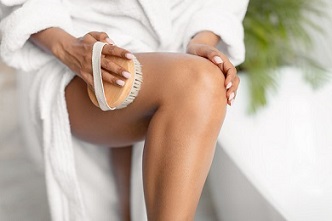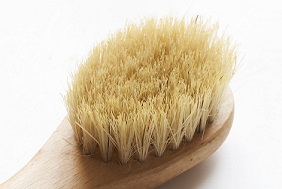Discover dry brushing! Learn its benefits for smooth skin, how it works, and if this natural wellness trend is right for you.
Your skin has been feeling a little dull. Maybe it’s rough in some areas, or you’ve been dealing with bumps that don’t disappear. Someone mentions dry brushing, and it’s all over your TikTok and YouTube. But what exactly is dry brushing, and should you rub your skin with a stiff brush?
In 2025, dry brushing has become one of Nigeria’s wellness circles’ most talked-about skincare trends. From skincare influencers in Lekki to natural beauty lovers in Abuja, more people are adding dry brushing to their weekly routine. In this guide, we break it all down—what dry brushing means, how it works, its benefits, side effects, and whether it’s worth your time.
What is Dry Brushing?
Dry brushing is brushing your skin using a firm, dry bristle brush. It’s usually done on dry skin before taking a shower. The goal is to exfoliate dead skin cells, improve circulation, and leave your skin feeling smooth and refreshed.
Unlike scrubs or soaps, dry brushing doesn’t involve water, oils, or creams. Just you, a body brush, and a few minutes of your time. It sounds basic, but it has roots in Ayurvedic and ancient wellness practices that go back hundreds of years.
In today’s world, it’s a popular self-care ritual that is said to offer more than just smooth skin.
How Does Dry Brushing Work?
Dry brushing works by gently removing the top layer of dead skin cells using a stiff-bristled brush. You make long strokes towards your heart, which many believe helps stimulate blood flow and lymphatic drainage. Some people also say it energises them and helps with fluid retention.
While science hasn’t confirmed all the benefits dry brushing fans claim, dermatologists agree on one thing: regular exfoliation helps skin texture. Dry brushing can provide that, as long as it’s done correctly.
Dry Brushing Benefits: What People Love About It
Many Nigerians who dry brush weekly say they’ve noticed visible improvements in their skin. Here are the most common dry brushing benefits people talk about:
- Smooth Skin
The most noticeable benefit of dry brushing is softer, smoother skin. It helps remove flaky patches and rough spots, especially on the arms, elbows, knees, and thighs.
- Exfoliation Without Chemicals
Dry brushing doesn’t require any product—no scrubs, acids, or oils. This is a big plus if you’re into natural skincare.
- Better Blood Flow
Some users say they feel more awake and refreshed after brushing, similar to how you feel after a quick jog or massage. This is likely because of increased blood circulation.
- Lymphatic Support
Dry brushing is believed to support the lymphatic system, which helps clear toxins from the body. While not fully backed by science, many wellness experts include dry brushing in detox routines.
- Temporary Reduction in Cellulite Appearance
Some users say dry brushing helps reduce the appearance of cellulite. It doesn’t remove cellulite but can temporarily smooth out the skin’s surface.
Dry Brushing Side Effects and Who Should Avoid It?
Like many skincare practices, dry brushing is not for everyone. Here’s who should approach it with caution:
- Sensitive Skin Types: Dry brushing might cause redness or microtears if your skin gets irritated easily.
- Skin Conditions: People with eczema, psoriasis, or open wounds should avoid it entirely. Over-brushing: Doing it too often or too harshly can damage your skin barrier.
Always listen to your skin. If it feels raw, itchy, or starts breaking out, pause the routine.
How to Dry-Brush Your Skin the Right Way
If you’re ready to give it a try, here’s how to dry brush properly and get the most benefits without hurting your skin:
Step-by-Step Guide:
Choose the Right Brush
Look for a brush with firm but gentle bristles and a long handle that can reach your back. If you have sensitive skin, try this Kitsch Dry Brushing Body Brush with soft bristles that will not harm your skin.
- Start at the Feet
Begin at your feet and work your way up using long, upward strokes. - Always Brush Toward Your Heart
This is believed to follow the natural flow of blood and lymph. - Use Circular Motions on the Stomach and Joints
For areas like your tummy or elbows, small circles work well. - Don’t Brush Your Face With the Body Brush
Use a softer, face-specific brush if you want to exfoliate your face. - Shower Afterwards
Wash off the dead skin cells, then moisturise with a good body cream or oil. - Don’t Overdo It
2–3 times a week is enough for most people.
Should You Try Dry Brushing? Final Thoughts
If you’re looking for a natural way to exfoliate, improve your skin texture, and boost circulation, dry brushing might be worth trying. It’s affordable, easy to do at home, and doesn’t require expensive products.
Just be gentle, stay consistent, and don’t forget to moisturise after each session. Like any skincare routine, the results show over time, not overnight.
Remember: If you have any underlying skin conditions, check with a dermatologist before starting.






